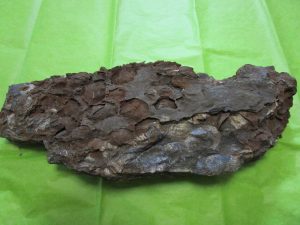It’s been a pretty busy year so far and only just last week did I finally get the chance to do a little fossil hunting. I’ve been especially anxious to pay a quick visit to my favourite fossil site because the Pennsylvania Department of Transportation (PennDOT) has spent the last two years doing major renovations to the highway that goes right past the site and I was afraid that all the fossils may have been paved over.
I needn’t have worried. The site, which is an old abandoned quarry, was mostly intact and PennDOT had even paved a small, 4-5 meter long entrance where you can park your car. There were still tons of rocks containing fossils, and it doesn’t take long to find some that are literally covered in them, see picture below.

Now I live in Philadelphia, and the city itself is totally barren of fossils. This is because bedrock upon which Philly sits is completely composed of igneous rock, cooled and solidified lava and magma and you don’t find fossils in what was once molten rock!
However, if you drive an hour and a half or more in any direction from Philly you can find many fossil sites, some that are very well know to both professional and amateur paleontologists. To the east and south, in New Jersey and Delaware you have a number of locations where fossils from the Cretaceous period can be found. The cretaceous period was the last period when dinosaurs walked the Earth. I have over a hundred fossils from sites in New Jersey and Delaware but unfortunately no dinosaurs.
My favourite site however is in the opposite direction, north and a bit to the west in Schuylkill County. Now the fossils you find north and west of Philadelphia are much older than the cretaceous period, older than any dinosaur. In my collection I have fossils from the Ordovician period (about 450 million years ago) through to the Pennsylvania period (around 300 million years ago). In Schuylkill County alone I know of a dozen places to find fossils and the nearby counties of Carbon, Monroe, Lebanon and so on are filled with fossil sites.
So how does someone go about finding fossils? Where should you look? What equipment do you need?
Let’s start with equipment because to start you really don’t need very much. In fact your clothing is probably more important than any equipment. Fossil sites are obviously outdoors, usually in wild, overgrown areas. Here in Pennsylvania the greatest danger in fossil hunting is actually ticks! Lyme disease is a real threat so I always wear long pants, a long sleeved shirt and practically pour insect repellant over my exposed areas. Sunscreen is also very useful even on partially sunny days. Also, even if you think the temperature is fairly cool when you start, let’s say 20ºC, once you get working you’ll find yourself getting quite hot so make certain you have a nice cool drink with you.
As far as equipment is concerned a good 10x magnifier is probably more useful than a geologist’s hammer and some stone chisels. Another very important piece of equipment is just some wood glue; at least 10% of my fossils are being held together by glue.
Now, the most important thing, let me say that again, the most important thing is to keep the fossils you collect from one site completely separate from fossils collected at other sites. At the same time you must record the location of each site from which you collect fossils.
Each site from which you collect fossils has its own age; and it had its own environment when those animals lived there. If your collection is to have any scientific value you must keep fossils from different places segregated and identified as to exactly where they were found. I have fossils from over seventy-five locations across the U.S. and keep a record of every single fossil, where it was found and what I think it is.
As far as identifying your fossils is concerned that can require a considerable amount of study and effort. However there are plenty of books available to aid you. Just go to Amazon and look up books on fossils, you’ll find dozens. Identifying fossils is a skill that can take quite a while to acquire but once you start recognizing your fossils the moment you pick them up you’ll be happy you put the effort into it.
Now this blog is about science in general, not specifically fossils. If you’d like to learn more about fossil collecting however, especially fossils near where you live, I recommend contacting you state’s department of natural resources or state geologist. Every state, and most countries have information on fossil collecting within their borders. Of course there are also plenty of Internet sites dedicated to fossil collecting so I’m going to provide a link to some of what I consider the better sites.
Fossil Guy is a private site like mine but totally devoted to fossils. Lots of good information and a great place to start. Follow the link below.
For people who want to visit fossil sites that have been turned into museums, that is no collecting here but great fossils to see.
http://www.topvaluereviews.net/30-most-impressive-fossil-sites-in-north-america/
Here’s some information on a site not far from my favourite site.
http://montourpreserve.org/fossil-pit/
I have quite a few fossils from Texas, a great state for fossils. Here’s a site with some info for Texas.
https://texasheritageforliving.com/texas-travel/best-places-to-find-fossils-in-texas/
Finally let’s go overseas and see what fossils can be found in the UK.
http://www.discoveringfossils.co.uk/locations.htm
Good Luck and have Fun!
